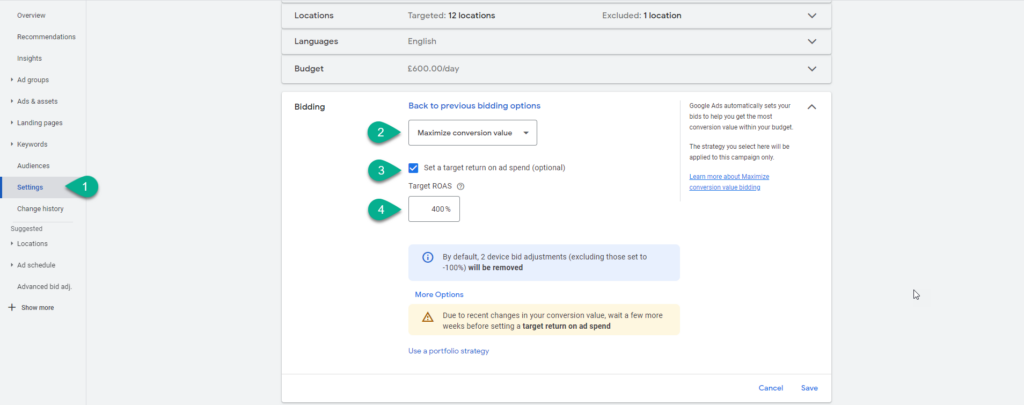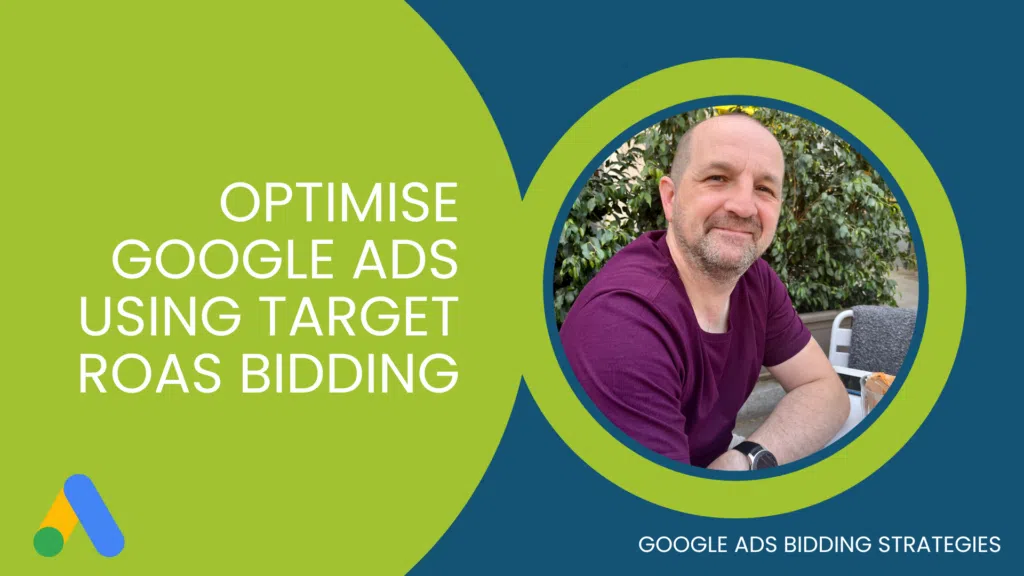In the world of business innovation and promotion, the primary goal is to optimize the effectiveness of your investment in advertising. A technique to achieve this objective involves the utilization of Target ROAS bidding within the Google Ads framework. Target ROAS, an acronym for Return On Ad Spend, represents a bidding tactic designed to amplify your earnings while upholding a designated ROI (return on investment) level. This article aims to elucidate the concept of Target ROAS, identify its suitable users, provide configuration guidance, and present proficient methods for its successful implementation.
This post is part of the Google Bidding Strategies Guide — created by our Google Ads Agency Team
In this series:
- Manual CPC Bidding in Google Ads: A Comprehensive Guide
- Enhanced CPC (eCPC) Bidding In Google Ads Explained
- How to Optimise Google Ads Using Target CPA Bidding
- How to Optimise Google Ads Using Target ROAS Bidding
- Google Ads Maximise Conversions Bidding Strategy Explained
- Google Ads Maximise Clicks Bidding Strategy Explained
- Google Ads Target Impression Share Bidding Strategy
- How and When to Use the Maximise Conversion Value Bidding Strategy in Google Ads
- Choosing the Best Bidding Strategy for Google Display Ads
- Every YouTube Ads Bidding Strategy Explained
- Bidding Strategies to Maximise Google Shopping Performance
- Manual Bidding vs Automatic Bidding: Which is Better?
What is Target ROAS Bidding?
Target ROAS stands as a bidding approach enabling you to establish a specific desired return on investment (ROI) for your advertising expenditure. With this strategy in place, Google Ads takes the reins, automatically adapting your bid amounts to maximize your revenue while upholding your designated ROI threshold.
To illustrate, suppose you aim for a 200% ROI on your ad spend. By setting a Target ROAS of 200%, Google Ads will take the initiative to tweak your bids in an effort to attain that desired ROI level.
It’s worth noting that you might come across ROAS metrics expressed as ratios, such as 2:1, which is equivalent to a 200% ROI, or 4:1, which corresponds to a 400% ROI.
When You Should Use Target ROAS Bid Strategy
Target ROAS bidding is an ideal choice for advertisers with a core aim of heightening revenue, all the while upholding a distinct return on investment (ROI). This strategy holds special significance for e-commerce enterprises aiming to propel sales and revenue via the platform of Google Ads.
Within the realm of e-commerce, it’s often the norm to secure varying profit margins for different product categories or even individual items. In such scenarios, our suggestion is to establish distinct campaigns for each product group, tailoring the Target ROAS bid to align with the specific characteristics of each group.
Success with Target ROAS
Numerous tales of triumph within the business sphere revolve around enterprises harnessing Target ROAS bidding to propel revenue through Google Ads.
Consider the Turkish e-commerce titan, Hepsiburada, which orchestrated a remarkable 104% surge in campaign earnings via Target Return on Ad Spend (ROAS) bidding. With a judicious target ROAS of 3.5, the company adeptly honed bid strategies to extract maximum revenue, culminating in a substantial amplification of campaign efficacy.
Similarly committed to maximizing ROI, Tatilbudur.com, an online travel agency, astutely embraced a focused Return on Advertising Spend (ROAS) bidding strategy. This strategic implementation bore fruit, manifesting as a striking 36% upswing in conversion value, coupled with an impressive 20% reduction in cost per conversion.
The astuteness of Tatilbudur.com’s approach lay in orchestrating separate campaigns for each product category, followed by the integration of target ROAS bidding into each campaign. This tactical manoeuvre permitted meticulous bid adjustments, meticulously aligned with the distinct ROAS aspirations for each category.
Via diligent scrutiny of conversion metrics and the subsequent recalibration of bids, Tatilbudur.com orchestrated campaign optimization, culminating in a heightened return on ad spend.
How to Configure Target ROAS Bidding
To engage in Target ROAS bidding, ensure accurate eCommerce conversion tracking within your Google Ads account, recording precise sales figures for each transaction.
For the effective refinement of your bids through machine learning, a robust reservoir of conversion data is crucial. Google Ads leverages the prowess of machine learning to fine-tune and elevate your bidding approaches. Thus, a substantial pool of conversion data translates into a streamlined and accelerated bid optimization process.
To set up Target ROAS bidding, follow these steps:
- In your Google Ads account, click on the campaign you want to edit.
- Click on “Settings” in the left-hand menu.
- Click on “Bidding” and then “Change bid strategy.”
- Select “Maximise Conversion Value” from the list of bidding strategies.
- Confirm that you’d like to set a Target ROAS and enter the value.

Target ROAS vs Target CPA Bidding
In Google Ads, businesses have the option to employ two distinct bidding strategies, namely Target ROAS (Return on Ad Spend) and Target CPA (Cost per Acquisition), each tailored to achieving specific advertising objectives. While both strategies share the overarching goal of enhancing return on investment, they diverge in their methods.
Target ROAS functions as a bidding approach engineered to amplify business revenue by setting a precise goal for the revenue-to-ad spend ratio. This tactic takes into consideration the average value of a conversion and aids businesses in judiciously distributing their budget among campaigns and ad groups projected to yield the highest revenue.
For instance, envision a business vending products with an average order worth of £100 and an envisaged target ROAS of 500%. In this scenario, the aim is to generate £5 in revenue for every £1 spent on advertising. Leveraging historical performance and data, Google Ads will autonomously tweak bids for keywords, ad groups, and campaigns to realize this target.
In contrast, Target CPA operates as a bidding strategy engineered to secure the maximum feasible conversions while sustaining a set cost per acquisition. This strategy takes into account the highest amount a business is willing to expend for a single conversion, promptly adjusting bids to realize the stipulated target CPA.
To illustrate, if a business sets a target CPA of £50 for a given campaign, Google Ads will seamlessly adapt bids for keywords, ad groups, and campaigns to achieve this objective. Consequently, the business will cap its payment at £50 for each conversion, although the overall conversion count might be fewer compared to Target ROAS bidding.
Popular eCommerce Videos
For a clearer distinction, let’s consider two identical stores vending the same product. Store A adopts Target ROAS bidding, while Store B opts for Target CPA bidding. Both establishments allocate a £500 budget for advertising, yielding conversions as follows: Store A attains 10 conversions, generating £1,000 in revenue; meanwhile, Store B secures 20 conversions, resulting in £800 in revenue. In this scenario, Store A emerges with a superior ROAS, given their ability to garner higher revenue per advertising expenditure.
Learn more: How to Optimise Google Ads Using Target CPA Bidding
Target ROAS vs. Maximise Conversion Value
Both Target ROAS (Return on Ad Spend) and Maximise Conversion Value serve as bidding strategies that aid businesses in refining their advertising expenditures. However, these strategies exhibit nuances in their methodologies and objectives.
Target ROAS functions as a bidding approach aimed at enhancing a business’s return on ad spend through the establishment of a particular target for the revenue-to-ad spend ratio. Anchored in the average conversion value, this strategy assists businesses in thoughtfully apportioning their budget to campaigns and ad groups with the potential for optimal revenue generation.
To exemplify, let’s delve into a scenario where a business upholds an average order value of £100 and sets a target return on ad spend (ROAS) of 500%. In such an instance, the sought-after outcome would be generating £5 in revenue for every £1 dedicated to advertising. Google Ads, drawing from historical data and performance, will dynamically adjust bids for keywords, ad groups, and campaigns to hit this goal.
Conversely, Maximise Conversion Value operates as a bidding strategy that zeroes in on amplifying revenue attainment within a designated budget. This strategy autonomously adapts bids for keywords, ad groups, and campaigns to optimize the accrual of conversion value, even if that entails a budget allocation below its maximum capacity.
Imagine a hypothetical scenario where a business earmarks £1,000 for advertising, aspiring to optimize revenue generation. Through Maximise Conversion Value bidding, Google Ads tailors bid to target users likely to trigger high-value conversions, even if this implies a higher cost per click.
Furthermore, let’s visualize a store offering two distinct products: one commanding considerable revenue per conversion, and the other showcasing comparatively modest revenue per conversion. Under Target ROAS bidding, Google Ads will channel a larger portion of the budget toward the campaign spotlighting the high-revenue product due to its superior ROAS. However, under Maximise Conversion Value bidding, Google Ads will funnel the budget toward whichever product yields the highest revenue, irrespective of individual revenue per conversion metrics.
The choice between Target ROAS and Maximise Conversion Value hinges upon your advertising objectives. Opt for Target ROAS if your priority centres on generating revenue at a specific target ROAS. Conversely, embrace Maximise Conversion Value if your goal entails extracting the maximum feasible revenue within a predefined budget.
Learn more: How and When to Use the Maximise Conversion Value Bidding Strategy in Google Ads
Target ROAS vs. Manual CPC Bidding
Target ROAS (Return on Ad Spend) and Manual CPC (Cost per Click), present businesses with the means to accomplish tailored advertising objectives. While both strategies furnish businesses with command over their ad expenditure, they diverge in methodology.
Target ROAS stands as a bidding strategy engineered to elevate business revenue by designating a precise objective for the revenue-to-ad spend ratio. This strategic approach factors in the average conversion value, assisting businesses in prudently distributing their budget to campaigns and ad groups poised to yield optimal revenue.
For instance, consider a scenario featuring a diverse product array within a store, including two specific items. The first product garners considerable revenue per conversion, while the second product generates comparatively lower revenue per conversion.
Upon adoption of Target ROAS bidding, Google Ads will assign a greater portion of the budget to the campaign highlighting the high-revenue product, given its superior ROAS. This is attributed to the strategy’s core objective of revenue maximization, surpassing the mere pursuit of clicks.
Recent Google Ads Blog Posts
Contrasting with Target ROAS, Manual CPC bidding stands as a strategy affording businesses unfettered authority over their bids for keywords, ad groups, and campaigns. This approach empowers businesses to determine their own maximum CPC bids and exert full control over their advertising expenditure.
For instance, envision a scenario where a business aspires to amplify clicks to its website. In this context, adopting manual CPC bidding allows them to boost bids for keywords driving the highest click volumes. Nevertheless, it’s important to note that this tactic might not necessarily translate into heightened conversions or revenue. Unlike Target ROAS, manual CPC bidding doesn’t factor in the average value of conversions.
Learn more: Manual CPC Bidding in Google Ads: A Comprehensive Guide
How to Calculate Return on Ad Spend (ROAS)
ROAS is calculated by dividing your revenue by your ad spend.
The formula for calculating ROAS is:
ROAS = Revenue / Ad Spend
To provide an illustration, suppose you invested £1,000 in Google Ads and the resulting revenue amounted to £5,000. In this case, your return on ad spend (ROAS) would be calculated as £5,000 divided by £1,000, yielding a ROAS of 5:1 or 500%.
Target ROAS Best Practices
Here are some best practices for using Target ROAS effectively:
- Make sure you have conversion tracking set up correctly and have enough conversion data to support machine learning.
- It is important to note that the availability of a larger volume of data contributes to both the accuracy and speed of machine learning processes. The more data you have at your disposal, the greater the precision and efficiency with which machine learning algorithms operate.
- Start with a conservative target ROAS and gradually increase it as you see positive results. Typically, use a strategy which focuses on clicks to gain conversion data, then move to Target ROAS, setting the target at or around the ROAS achieved by the previous strategy.
- Monitor campaign performance regularly and continue to optimise ad copy, structure and use negative keywords to improve traffic quality. Once the ROAS achieved is stable and consistent, you can begin to increase the target carefully.
- Focus on improving your website’s conversion rate to increase your ROI.
The Importance of Conversion Rate Optimisation
Conversion rate optimization (CRO) involves enhancing your website’s capacity to transform visitors into customers. This constitutes a vital facet of any Target ROAS strategy since it directly influences your return on investment (ROI).
Learn more:










